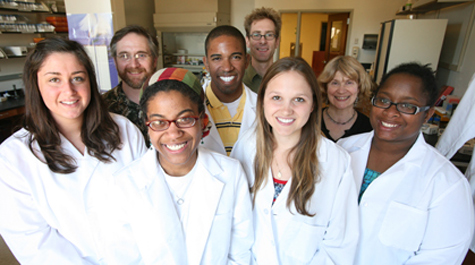CrimD moves into the spotlight
“We were contacted by the University of Pittsburgh—Graham Hatfull’s laboratory,” said Margaret Saha of William & Mary’s biology department. “They consider our ‘Oscar nominee’ so interesting and so unique that we have the opportunity to collaborate with them.”
CrimD was discovered last year by a group of freshmen participating in a special research experience for first-year students sponsored by the Science Education Alliance of the Howard Hughes Medical Institute (HHMI). Drawn from the mud of campus landmark Crim Dell, CrimD was determined to be a previously unknown variety of bacteriophage, a group of viruses that infect bacteria.
Some 30 first-year students were involved in last year’s HHMI phage lab, working with a faculty team comprising Saha and her fellow microbiologists Mark Forsyth and Kurt Williamson. Hatfull is an HHMI Professor at Pitt and has been interested in CrimD since the virus was sequenced.
There are a couple of things that make CrimD stand out from the crowd of new phages discovered in HHMI phage seminars at dozens of universities. As phages don’t reproduce sexually, they aren’t part of the Linnean “family-genus-species” classification, and, instead, are grouped in clusters.
“That’s what makes CrimD so interesting; it’s not in any previously existing cluster,” Williamson said. “It forms its own with a phage called TM4 that was sequenced many years ago—and just hanging out by itself, unclustered. TM4, CrimD and this other phage called Angelica have formed their own cluster.”
There’s more than academic interest in CrimD and its cluster mates. They all infect different species of mycobacteria, a family that includes the causative agents of a group of diseases that include tuberculosis and leprosy.
“There is a lot of excitement that CrimD might infect Mycobacterium tuberculosis and therefore have real benefit as a therapeutic agent or, more likely, doing genetic manipulations to help find better treatments of TB,” Williamson explained.
The three William & Mary biologists are working with six alumni of last year’s freshman phage lab. Forsyth explained that the work is being done at Pitt because Hatfull’s lab has the Biosafety Level 3 designation necessary to work with pathogens, such as tuberculosis, that are dangerous to humans.
The team at William and Mary will continue to work with CrimD, cleaning up rough spots in the sequencing of the virus’s DNA and re-annotating the gene groups blueprinted in the genetic sequencing. The students involved are Allison Perz, Hilary Whelan, Kobie Gordon, Jillian Walton, Arrykka Jackson and Jordan Bonz Hudson.
“The students are doing all the work. Everything! They’re doing the re-annotating. They will do the experiment,” Saha said. “And we’re just overseeing it.”
















